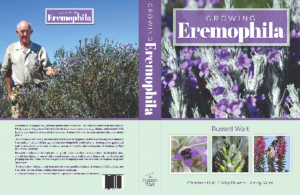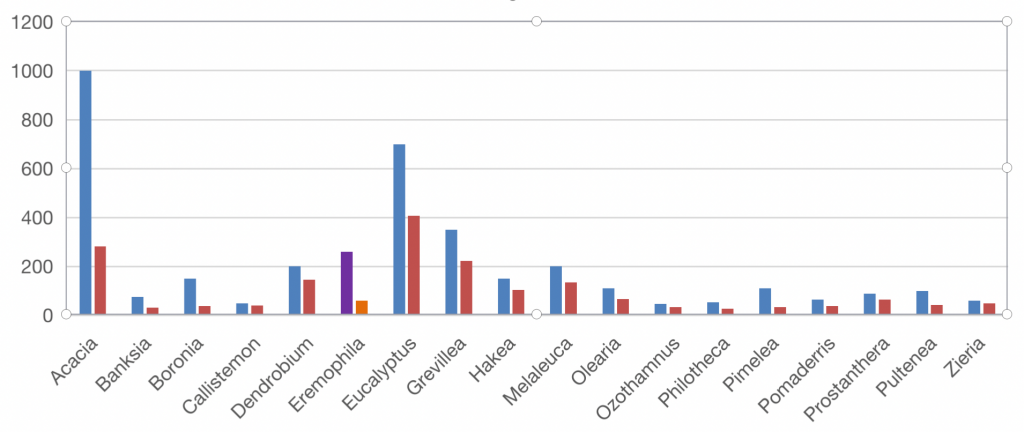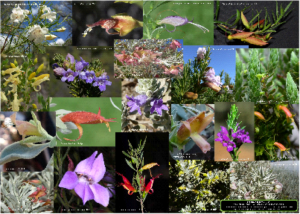This is an edited transcript of the talk that Lyndall gave at the ANPSA conference 2022

Hello everyone and thanks for your time today.
You know I am leader of the Eremophila Study Group. It is one of 15 active study groups that are run under the auspices of the federal organisation to which NSW APS belongs.
What you may not know is that Eremophila, which also called Emu Bush, Poverty Bush, Turkey Bush or Fuchsia Bush, is the 5th most diverse native genus with around 240 described species and many more sub-species and hybrids.
Eremophila are widely distributed in areas of Australia with less than 250mm rainfall. Around 75% of species are insect pollinated and 25% are bird pollinated. That means that the species within the genus have a massive diversity in flower colour and shape. The ones that are bird pollinated have red, orange, yellow, cream and green flowers and those that are insect pollinated have blue, purple, pink and white flowers (so, any colour you like). They are long lived and range in size from flat on the ground up to a tree – so there is a space for an Eremophila in your garden.
I am going to talk about the future today, but I do want to touch on the fact that it is our 50th anniversary and I want to cover the first 50 years of what we’ve done to give you the context for what is happening in the future.
The early years
The Study Group (SG) was formed in 1972, following Project Eremophila, led by Margaret Lee and Ken Warnes, with the support of the SA region. At that stage there were three species in cultivation – two with yellow flowers and one with white flowers.
Ken served as the founding SG leader until 1980, by which time 30 – 50 species were being cultivated. He was responsible for registering the first named variety (E. maculata ‘Carmine Star’) with ACRA. He, with Peter and Ronda Hall, also sourced the plants for the first Eremophila collections in the then new Australian Arid Lands Botanic Gardens (SA) and Myall Park Botanic Gardens (Qld).
Meanwhile, Dave Gordon and Noel Gane in Sydney were working out how to grow them in raised beds in wetter regions.
Grafting, first suggested in 1975, became an important tool for maintaining plants in wetter soils. When the first attempts onto other Eremophilas didn’t work, SG members tried the related genus of Myoporum. It is still the only way to propagate >50 species.
The SG also developed cutting mixes for propagation, led by the next leader, Geoff Needham. Frost tolerance was also addressed during the 1980s and we now know more than 100 varieties can withstand hard frost.
Eremophila gradually appeared in plant sales through enthusiasts who also found interesting hybrids. These included Ken Warnes, Russell Wait, Frank Schilling. Tom Loffler and Frank Fitzpatrick. Plants were sold through specialists such as Peter and Marion Lang (SA), Phil James (WA) and Phil Vaughan (Vic).
By 1995 the third SG leader, Colin Jennings, published the Study Group’s first book on horticulture of the genus, and garden experimentation revealed that Eremophila like being fertilised and pruned (just like normal plants!).
I might say that over this period academic work relied on a very small number of enthusiasts – a few chemists, one significant PhD thesis on germination, and one person working very hard on taxonomy. That taxonomist was Bob Chinnock, who published Eremophila and Allied Genera in 2007. This described 216 species and provided the first technical book widely available to the public.
Prior to that, the SG newsletters were the only available source of information and, for gardeners, remained the only non-academic source up until 2008, when a group of three members published the first horticultural book Eremophilas – Changing Gardens for a Changing Climate.
So the first 40 years of the study group saw it lead collection of species from the wild for both taxonomic work and horticulture; develop propagation methods, understand frost resistance and general horticultural support, and start to raise awareness and increase public use.
The last decade
In the last 10 years there has been an explosion of interest and Eremophila have finally become an overnight success. Cutting grown and grafted plants are regularly available in nurseries, and we know of 27 nurseries (outside APS sales) where a good range of species is sold. And, you can buy them in Bunnings!
Two more “pop ular” books have been published on the genus – a field guide and another horticultural book, and an issue of Australian Plants Journal was dedicated to Eremophila in September 2021. The species count now stands at 240, but by the time the taxonomists have finished there may be 300 species described.
ular” books have been published on the genus – a field guide and another horticultural book, and an issue of Australian Plants Journal was dedicated to Eremophila in September 2021. The species count now stands at 240, but by the time the taxonomists have finished there may be 300 species described.
More recently, Rachael Fowler really threw the genetic cat amongst the Eremophila pigeons by comparing the existing species based on morphology with the underlying genetic relationships. There are some differences! Rachael has suggested that Eremophila will either have to be split into multiple genera, or the other genera in the family merged in(there are another five genera in the family Scrophulariaceae). Rachael’s group has submitted an application to keep the genus name as Eremophila, based on the number of species – because otherwise it is going to have to be Bontia, and we don’t want that!
The Study Group has been gradually forming relationships with academia and researchers from South Australia and NSW have presented their work at our events in 2017 and 2021.
We are very fortunate to have a lot of dedicated people in our study group and our chapters in SA, Qld, NSW and Victoria are led by keen members who have held things together despite drought, fire, COVID, floods and the recent rain, which has been quite depressing if you are trying to grow a desert plant.
Thanks to Brian Walters and the fantastic support of a group of photographers, we also have a searchable image database on the SG website (boasting almost all the described species). The Gardening with Angus website also has articles about Eremophila. And an enthusiastic Bryan Rau, from the APS SA Fleurieu Group, administers the Old Man Emu Bush Facebook page.
We also have a relationship with a wholesale nursery. Through this we ensure that new varieties for release have accurate labels. We have been involved in the release of 8 varieties[ Mallee Lipstick, Ray’s Blue, Meringur Midnight, E. waitii Silky Lavender, Pink Pantha, Beryl’s Gem, Fruit Salad, Yanna Wonder ] since 2019 and, believe it or not, 36,000 Eremophila that have been or are currently in nurseries that have a label SG by name and talks about our work.
So, you can see that the SG and its ~160 members have built up a significant body of knowledge towards meeting SG and ANPSA goals in expanding Eremophila in horticulture, and in enhancing public understanding of the genus. We know we have all but 6 of the named species in cultivation by at least one person., However, of > 230 species that are in cultivation, 18 species are grown by only one person, and a further 21 species are grown by only 2 people. So we have a way to go in terms of market penetration.
Where to now?
So that is the history – where are we going next?
In March 2021 a lively debate at a SA group meeting in Kadina led to the SG issuing a call for expressions of interest for academic institutions to work with us researching seed germination. Purposeful germination of seed has always been problematic, which is why we grow them by either cutting or grafting. This can lead to problems with genetic diversity. We have selected the University of Queensland at Gatton as our partner.
We asked SG members to collect fruit and within a very short time the University had to hand over 3000 fruit from 60 home-grown species. Interestingly, when they started to X-ray them, many fruit were empty. This was puzzling – is it because the pollinators were missing? Was it because of some deficiency in the soil? After thinking a bit further with the university we developed a couple of projects and we have funding for them!
The first is studying seed fill in wild Eremophila from Queensland and is funded by a grant of $23,000 from Native Plants Qld (NPQ), with a total project size of ~$45,000. SG members from NSW, Victoria and South Australia have collected over 1500 fruit from 12 of the 24 species in western Queensland that we are allowed to collect. UQ is going to study seed fill using X-rays and will also analyse pollen samples. [ There is another $20,000 worth of work we know we can do under the NPQ project, but so far is unfunded. ]
The second project aims to understand dormancy and germination triggers, with a view to developing a better way to induce germination so Eremophila can be grown from seed to make them more suitable for mine site rehabilitation and to increase genetic diversity of what is growing in our gardens. At the moment, Eremophilas grown for mine site revegetation come from, I believe, tissue culture or direct application of gibberellic acid, which is expensive. We just learnt last week UQ, The SG and Kersbrook Landcare have a cash grant of $240,000 from the Australian Research Council for a project valued at about $400,000. That one starts in December.
Naming is a big bugbear. Under the existing nomenclature we know there are “bucket species” where everything has been shoved into one genus – notably Eremophila glabra.
The bigger issue, however, is consistency of common names. I know this is something we can’t solve but we need to keep plugging away at it. The same hybrids are sold under different names (e.g. ‘Wild Berry’ vs ‘Blue Thunder’). “Ordinary” examples of a species have cultivar names e.g. Eremophila youngii (Young’s Eremophila) is being sold as ‘Desert Pink’ but that is unlikely to be a special form or cultivar. And we have plain old wrong information e.g. the hybrid E. ‘Red Splendour’ (E. calorhabdos x E. splendens), has red flowers but online is advertised with a photo of the pink E. calorhabdos parent.
Linked to that is the issue of conservation which is something that is particularly hard for us because we live such a long way from where our plants grow.
Even if a plant is in cultivation, we may lose it in the wild, particularly where we have a high probability that a cultivated variety being sold nationally is a clone from a single wild collection. The germination work I mentioned earlier is one way to reduce that risk.
We may also lose the original plant because a cultivar has taken over e.g. the natural, multi-coloured form of E. racemosa has been overtaken in nurseries by the yellow and white cultivar ‘Peaches and Cream’, possibly because the latter lasts longer in the garden. The only place I know that you can buy the wild form is from the APS group in Kadina, unless you are in the US where you can buy it anywhere, and it is called the Easter Egg plant.
So, for me, one of the solutions is to work with the nursery industry and botanic gardens to try to make sure the wild species are conserved, while also finding good horticultural varieties.
We have excellent relationships with many smaller botanic gardens in SA, Queensland and the National Arboretum in the ACT, where we are advising on planting and maintaining Eremophila and are often providing some labour towards establishment and maintenance. All that has happened because our members have reached out locally and I think that is a really big role for us in the future.
But, there are gaps with the major city botanic gardens. This graph over shows the species the Australian National Botanic Gardens in Canberra grows as a percentage of the species that exist: the data are old, but shows they grow less than one quarter of Eremophila species, compared to 70-80% of Melaleuca/ Callistemons, 63% of Grevillea, 58% of Eucalypts and 28% of Acacia. I want to lift that percent and will reach out to them to see if we can help.

I think we can also educate and raise awareness amongst other groups. We have a relationship with Canberra Institute of Technology and have presented to their horticulture students. I have now developed an Introduction to Eremophila presentation which I aim to get out to all the TAFEs around Australia to increase student knowledge of native plants.
I have also discovered a group called Cool Australia which has a suite of primary school curriculum units on native bees. Wouldn’t it be good if they could have that on native plants?
And local governments are also important. We were in Quilpie (220mm rain p.a.) a couple of weeks ago. They are growing paperbark Melaleuca as street trees, complete with watering points. They should be growing Eremophila, they wouldn’t need watering!
So in 2072 when people look back at our next 50 years of achievements, what will they see?
- We will have solved the germination problem, in conjunction with our university partners;
- We will have Eremophila in our streetscapes;
- Eremophila will be widely available in nurseries AND will be correctly labelled;
- There will be big Eremophila collections in Botanic Gardens;
- We will have native plants in curricula for horticulture students; and
- Eremophilas will be as well-known as Acacia, Eucalypt and Grevillea for home gardens.
 You’ll note, I hope, that you can insert the name of many Australian plant genera here, so I am laying down the challenge for other study groups as well, and ANPSA more broadly.
You’ll note, I hope, that you can insert the name of many Australian plant genera here, so I am laying down the challenge for other study groups as well, and ANPSA more broadly.
What can you do? Go and buy a plant, join a Study Group, buy some 50th Anniversary merchandise so I can raise my final $20,000 for the rest of the Qld project. Lobby your local Council; tell the ABC they need more native plants on Gardening Australia. Go and look for Eremophila on your next holiday.
Finally, I’d really like to thank all the rally active people in our study group at the local level: sub-group leaders, photographers, IT support, ANPSA and researchers. A Study Group is only as good as the people who are in it, so please join us, join another Study Group and let’s get on with the next 50 years by getting going now.
Click here to see the Eremophila merchandise available and to download the order form
